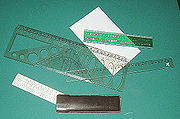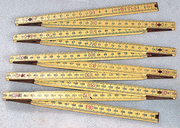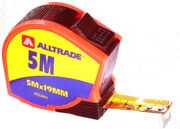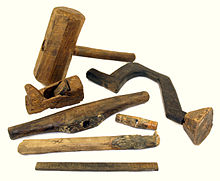- Ruler
-
For other uses, see Ruler (disambiguation).
A ruler, sometimes called a rule or line gauge, is an instrument used in geometry, technical drawing, printing and engineering/building to measure distances and/or to rule straight lines. Strictly speaking, the ruler is essentially a straightedge used to rule lines[citation needed], but typically the ruler also contains calibrated lines to measure distances.[1]
Contents
Types
Rulers have long been made of wood in a wide range of sizes. They are not however all wooden. Plastics have been used since they were invented; they can be molded with length markings instead of being scribed. Metal is used for more durable rulers for use in the workshop; sometimes a metal edge is embedded into a wooden desk ruler to preserve the edge when used for straight-line cutting. 12 inches or 30 cm in length is useful for a ruler to be kept on a desk to help in drawing. Shorter rulers are convenient for keeping in a pocket.[2] Longer rulers, e.g., 18 inches (45 cm) are necessary in some cases. Rigid wooden or plastic yardsticks, 1 yard long and meter sticks, 1 meter long, are also used. Classically, long measuring rods were used for larger projects, now superseded by tape measure or laser rangefinders.
Desk rulers are used for three main purposes: to measure, to aid in drawing straight lines and as a straight guide for cutting and scoring with a blade. Practical rulers have distance markings along their edges.
A type of ruler used in the printing industry is called a line gauge. These may be made from a variety of materials, typically metal or clear plastic. Units of measurement on a basic line gauge usually include inches, agate, picas, and points. More detailed line gauges may contain sample widths of lines, samples of common type in several point sizes, etc.
Measuring instruments similar in function to rulers are made portable by folding (carpenter's folding rule) or retracting into a coil (metal tape measure) when not in use. When extended for use they are straight, like a ruler. The illustrations on this page show a 2-meter carpenter's rule which folds down to a length of 24 cm to easily fit in a pocket, and a 5-meter-long tape which retracts into a small housing.
A flexible length measuring instrument which is not necessarily straight in use is the tailor's fabric tape measure, a length of tape calibrated in inches and centimeters. It is used to measure around a solid body, e.g., a person's waist measurement, as well as linear measurement, e.g., inside leg. It is rolled up when not in use, taking up little space.
A contraction rule is made having larger divisions than standard measures to allow for shrinkage of a metal casting. They may also be known as a 'shrinkage or shrink rule.[3]
Ruler applications in geometry
Main article: Compass and straightedgeIn geometry, a ruler without any marks on it (a straightedge) may be used only for drawing straight lines between points, not measuring. A straightedge is also used to help draw accurate graphs in algebra and other math subjects.
A ruler and compass construction refers to constructions using an unmarked ruler and a compass. It is possible to bisect an angle into two equal parts with ruler and compass. It can be proved, though, that it is impossible to divide an angle into three equal parts using only a compass and straightedge — the problem of angle trisection. However, should two marks be allowed on the ruler, the problem becomes solvable.
History
Rulers made of Ivory were in use by the Indus Valley Civilization period prior to 1500 BC.[4] Excavations at Lothal (2400 BC) have yielded one such ruler calibrated to about 1⁄16 in (1.6 mm).[4] Ian Whitelaw holds that the Mohenjo-Daro ruler is divided into units corresponding to 1.32 in (33.5 mm) and these are marked out in decimal subdivisions with amazing accuracy, to within 0.005 in (0.13 mm). Ancient bricks found throughout the region have dimensions that correspond to these units.[5]
Anton Ullrich invented the folding ruler in 1851.
Philosophy
Ludwig Wittgenstein famously used rulers as an example in his discussion of language games in the Philosophical Investigations. Wittgenstein pointed out that standard meter bar in Paris was the criterion against which all other rulers were determined to be one meter long, but that there was no analytical way to demonstrate that the standard meter bar itself was one meter long. It could only be asserted as one meter as part of a language game.
See also
- Dividing engine
- Geometry template
- Golomb ruler
- Measuring rod
- Rolling ruler
- Scale rulers: architect's scale and engineer's scale
References
Notes
- ^ Dictionary.com definition
- ^ "Steel Rule Has Pocket Clip For Use As A Depth Gauge" Popular Science, December 1935 pg.887 bottom right
- ^ http://www.answers.com/topic/contraction-rule
- ^ a b Whitelaw, p. 14.
- ^ Whitelaw, p. 15.
Bibliography
- Whitelaw, Ian (2007). A Measure of All Things: The Story of Man and Measurement. Macmillan. ISBN 0312370261.
External links
Types of tools Cleaning tools Broom · Brush · Feather duster · Floor buffer · Hataki · Ice resurfacer · Mop · Mop bucket cart · Office cleaning cart · Pipe cleaner · Pressure washer · Sponge · Squeegee · Steam mop · Tawashi · Vacuum cleanerCutting and
abrasive toolsBlade · Bolt cutter · Broach · Ceramic tile cutter · Chisel · Coping saw · Countersink · Diamond blade · Diamond tool · Draw knife · Drill bit · Emery cloth · File · Fretsaw · Froe · Glass cutter · Grater · Grinding wheel · Hand saw · Knife · Miter saw · Nail clipper · Pipecutter · Plane · Rasp · Razor · Reamer · Sandpaper · Saw · Scalpel · Scissors · Steel wool · Surform · Switchblade · Utility knife · Water jet cutter · Wire brush · Wire cutter · Wire stripperGarden tools Adze · Axe · Billhook · Bow saw · Chainsaw · Cultivator · Earth auger · Edger · Garden fork · Garden hose · Garden trowel · Hatchet · Hedge trimmer · Hoe · Hori hori · Irrigation sprinkler · Lawn aerator · Lawn mower · Lawn sweeper · Leaf blower · Loppers · Loy · Machete · Mattock · Pickaxe · Pitchfork · Plough (plow) · Post hole digger · Pruning shears (secateurs) · Rake · Roller · Rotary tiller · Scythe · Shovel · Sickle · Slasher · Spade · Splitting maul · String trimmerHand tools Block plane · BNC inserter/remover · Brace · Bradawl · Breaker bar · Card scraper · Cat's paw · Caulking gun · Clamp · Crimping pliers · Crowbar · Grease gun · Fish tape · Hammer · Hand truck · Hawk · Hex key · Jack · Lug wrench · Locking pliers · Mallet · Mitre box · Monkey wrench · Nut driver · Paint roller · Paintbrush · Pipe wrench · Pliers · Plumber's snake · Plunger · Punch · Punch down tool · Putty knife · Ratchet · Sink wrench · Scratch awl · Screwdriver · Sledgehammer · Socket wrench · Spike maul · Staple gun · Stitching awl · Strap wrench · Tire iron · Torque wrench · Trowel · Upholstery hammer · Wrench (spanner)Machine and
metalworking toolsAutomatic lathe · Ball-peen hammer · Broaching machine · Drill press · Endmill · English wheel · Gear shaper · Grinding machine · Hacksaw · Hobbing machine · Jig borer · Lathe · Metalworking lathe · Milling cutter · Milling machine · Planer · Plasma cutter · Screw machine · Shaper · Tap and die · Thread restorer · Tool bit · Turret lathe · WelderMeasuring and
alignment toolsArchitect's scale · Beam compass · Caliper · Chalk box · Compass · Engineer's scale · Flexible curve · Jig · Laser level · Laser line level · Laser measuring tool · Micrometer · Plumb-bob · Protractor · Ruler · Scale · Sliding T bevel · Spirit level · Square · Straightedge · Tape measure · TemplatePower tools Angle grinder · Bandsaw · Belt sander · Blow torch · Chop saw · Circular saw · Concrete saw · Crusher · Cutting torch · Die grinder · Drill · Glue gun · Heat gun · Impact wrench · Jackhammer · Jigsaw · Jointer · Nail gun · Needlegun scaler · Power trowel · Radial arm saw · Random orbital sander · Reciprocating saw · Rotary tool · Router table · Sander · Scroll saw · Soldering gun · Soldering iron · Steam box · Table saw · Thickness planer · Wood router · Wood shaperOther Antique tools · Backscratcher · Bucket · Comb · Flashlight · Halligan bar · Kelly tool · Ladder · Pencil · Toolbox · Vise · WorkbenchCategories:- Dimensional instruments
- Metalworking measuring instruments
- Stonemasonry tools
- Woodworking measuring instruments
- Stationery
- Inventions of the Indus Valley Civilization
Wikimedia Foundation. 2010.





